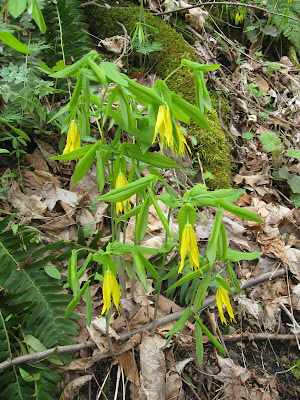My plans for an early morning start on a southern roadtrip were delayed by the Monday morning snowstorm. I waited for the morning rush to subside, checked my wiper fluid level and headed out. Roads were sloppy but much better than I expected and by the time I hit the Michigan/Ohio border there was no snow on the ground and at the end of the day the temperature had hit 80 and I was way overdressed.
My destination was West Virginia, specifically the New River Gorge Area near Fayetteville. Since I had gotten a late start I stayed in a campground just outside of town for the night. The campground was deserted except for a young man from Oregon who was tenting and had come down to do some white water rafting in the gorge.
Early Tuesday morning I left for Babcock State Park where I hoped to photograph my single target bird for the area-the Swainson's Warbler. I have only seen this rather unglamorous bird once during the spring migration on Dauphin Island. That look was very unsatisfying since it lasted only a few seconds and was obscured by vegetation as the bird scurried along the ground like a little mouse through the thick underbrush. Traditionally Swainson's Warblers were considered a bird of southern canebrakes until a population occurring in rhododendron thickets in the Appalachian mountains was found. The area around Babcock State Park is well known for such habitat. So well known, in fact, that a highlight of the New River Birding and Nature Festival in early May are tours to the area in search of the bird. Last year a single bird was found on the last day of the festival in pouring rain. You have to admire the tenacity of some birders.
Rhododendron thickets are habitat for Swainson's Warblers
My tenacity consisted of searching in good weather for two days along the rugged canyon created by Glade Creek. Old Sewell Road traverses the south side of the creek for six miles. This road (open only to hikers and mountain bikers) is a tremendous aid since the steep walls of the rocky canyon are almost impossible to navigate safely. During my two days there I only had to share the road with several groups of muddied mountain bikers who were training for an event later in the month.
Unfortunately I never saw or heard a single Swainson's Warbler. Perhaps I was too early or in the wrong spot. Some day I will have to attend the festival and hope the locals can scare up one for me. A return trip would be very tempting as this area is very beautiful. Babcock State Park has one of the most picturesque grist mills I have ever seen. Often seen on calendars it is at its best when rhododentrons are in bloom, or with a fall foliage backdrop, or covered in snow. A stay in one of the park's original cabins would be very relaxing.
The pre-leaf season I observed is also awesome. The spring wildflowers were just reaching peak (a wildflower hike was scheduled for the weekend).
Fern fiddlehead
Neotropical migrants and local breeders are just arriving with Black-throated Green Warblers, Black and White Warblers, Black-throated Blue Warblers, and Louisiana Waterthrushes in full voice. Also seen were Blue-headed Vireos, and Hooded Warblers.
Black-and-White Warbler
I usually go to upper Michigan for Black-throated Blue Warblers but here they are very common, although notice the black "smudges" on the back which the northern populations usually do not have while these Appalacian birds do.
Black-throated Green Warbler
While in the area a visit to the New River Gorge Visitor Center is a must. The bridge crossing the gorge was built in 1977 and is the world's largest single arch steel span bridge. It is the second highest in America and locals proudly tell you that you could stack two Statue of Liberties on top of the Washington Monument and all three would easily fit under the span.








































